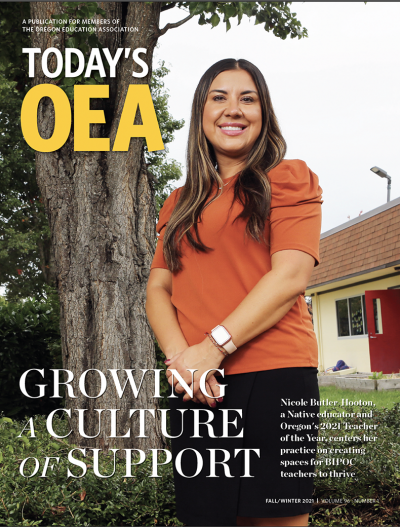When schools abruptly closed in March 2020 at the onset of the pandemic, Janell Oliger began to panic. As one of the co-presidents of Clackamas ESD Employee's Association, one of OEA’s few classified staff locals, she worried about the fate of her members’ jobs. Education Service Districts provide a wide variety of individual support to students with special needs in the districts they serve, which means that distance learning is not an option for many of their students, yet most of their worksites were closed anyway as part of the school closure mandate.
They, like many classified staff around the state, struggled to find footing in this new landscape. Luckily, Governor Kate Brown issued an Executive Order to ensure that all school employees be paid through the end of the 2019-20 school year, but the pressure was on to find ways to continue to work. The guidance they received from the state and from their own program leadership was minimal, so staff members began to take matters into their own hands to keep busy. They set up a shared spreadsheet where members could input web-based training and workshops that others might be interested in, and held discussion groups for those who attended. They filled in their downtime by learning how to use Google Classroom, which had become the platform of choice for most of the districts they served, studying and discussing early childhood mental health practices, and learning what they could do to manage their own stress levels during the early months of the pandemic. All of the work was local-driven. Nearly a month after schools had been closed, Clackamas ESD leadership adopted a similar tracking method for classified work.
The leadership and drive shown by Clackamas ESD EA members was rewarded with a shocking blow to their numbers. In August, the service district announced that there would be a significant reduction in classified staff. In September, 48 people were laid off. Oliger was supposed to be one of them. “That in itself was very hard because I've been having union meetings with our management since March and April and then all of a sudden I became not only the union representative but also someone who has just been laid off,” she says. As a leader, she struggled to find ways to support her members who had lost their jobs. Oliger was able to keep her position, but only because another employee had volunteered to retire. “I listened for hours and hours to people and received so many emails about people's stories,” she says, recalling the feelings of helplessness and fear for her colleagues and their families.
To add insult to injury, some of the employees who had been laid off received a letter from the district financial office informing them that they had been overpaid due to their payroll process. It’s common practice in Oregon school districts to divide employees’ salaries over twelve months so that they will receive pay during the summer months. Clackamas ESD classified employees paid on this system were given the option of forgoing a final paycheck, or continuing to work an additional two months with deductions being taken from their last two paychecks. It was a devastating blow for Oliger’s members, who were already facing unemployment.
The most difficult part for Oliger to understand is that due to CARES Act funding, the Clackamas ESD budget has remained whole for the current school year. Combined with the fact that many of the surrounding schools districts are still hiring for classified positions, it’s puzzling that nearly a quarter of Clackamas ESD’s classified staff was let go. For Oliger and many of her colleagues, it’s part of a much bigger pattern of ignorance and disrespect for the work of support staff. “The most common thing that I hear that people just don’t feel valued. And honestly, sometimes I just feel so defeated,” she says. Since the beginning of the 2020-21 school year, the expectations on support staff have only increased, and the remaining staff members are overwhelmed by the workload.
“I'm just in awe of the support from OEA. I’ve been president for four years, and the information and help that they have provided this past year has been amazing.”
Though this has been one of the most challenging experiences of her education career, Oliger is still fighting to ensure that the voices of her members are being heard by district leadership. She has attended every Clackamas ESD Board meeting since August, sharing testimony at many of them about the impact that the pandemic and these severe cuts to staff have made on the work that they do. She also encourages her members to join the monthly calls and share their own stories. Although she knows that doing these things won’t bring 48 members back to work, she refuses to let district leadership forget about them. “I get messages almost daily from my members, letting me know how much they appreciate me advocating for them. And I’m not trying to pat myself on the back, but those responses inspire me to keep going,” she says.
For now, Oliger is committed to support her members, current and former, in any way that she can. One of the biggest challenges that she and her colleagues have with Clackamas ESD leadership is a lack of communication, so Oliger is determined to give members as much information as she can. In addition to weekly emails, she sends monthly board meeting reminders and summary notes to keep her colleagues up-to-date. She also makes sure that they are aware of any funding available to help those in need, such as OEA’s Relief Fund grants for members who were laid off or impacted by wildfires this past year. She says that these programs have been a blessing for her local, which has been hit hard by both layoffs and wildfires. “I'm just in awe of the support from OEA. I’ve been president for four years, and the information and help that they have provided this past year has been amazing.”

